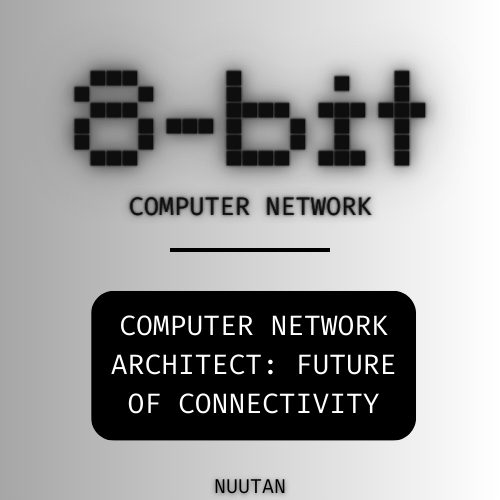Computer Network Architect: Designing the Pathway to Digital Connectivity
(1) Introduction
Complex networks are created and maintained by computer network architects. They play an essential role of present-day data sharing and communication.
(1.1) Defining a computer network architect’s role:
They plan, carry out, and oversee effective and safe networks essential to fostering smooth communication between organizations and people. Past turning points like ARPANET provided the framework for its function.
(1.2) Development of computer networking historically:
Packet switching was invented by ARPANET in the 1960s, which helped create the internet. Local area networks (LANs) were facilitated by Ethernet in the 1970s. Networking protocols were standardized in the 1980s by TCP/IP. In the 1990s, the World Wide Web made the internet more lucrative. Wireless and broadband technology improved connectedness. Networking is still changing as a result of on-going innovations like cloud and IoT.
(2) The journey of a computer network architect
- Background in education: They earn a Bachelor’s or higher degree in Computer Science or a closely related discipline.
- Training and development: They take courses in specialized networking and receive practical expertise in the field.
- Certifications: They are aiming for credentials that are respected in their field, such as CCIE and CCNA.
(2.1) Certification in networking, past, present, and future:
Certifications for networking expertise first appeared in the 1980s. An example of Cisco’s influence is the company’s 1993 introduction of the Certified Internetwork Expert (CCIE) credential. Certifications have branched out to include a wider range of fields, such as cyber-security and the cloud. Certifications are kept up-to-date with the constantly evolving technological landscape. Networking certificates are valued and respected all over the world, helping to further job prospects. Modern network management requires the expertise of certified professionals.
(3) The Importance of Realizing the Value of Computer Networks
Networks of computers are essential because:
- Seamless communication: They make it possible for people and businesses to communicate quickly and easily.
- Quick information transfer: Networks make it easy to share data, which improves efficiency and productivity.
- Global connectivity: Through them, people and companies all around the world are linked together, regardless of physical distance.
- Sharing files, printing, and software applications: Networks make it possible to pool resources like these, leading to greater productivity.
- Economic growth: Through enabling online commerce, services, and digital innovation, they fuel economic expansion.
- Influence on society: Networks facilitate current forms of communication through facilitating social connections and online groups.
(4) What a computer network architect is supposed to do
As one who designs computer networks:
- Creates plans and constructs networks with the organization’s long-term objectives in mind;
- Uses only the most effective technology and parts;
- Exact in the integration and deployment of network systems;
- Protects the network with several levels of defence; and
- Maintains a constant vigilance over the network and tweaks settings to improve speed and uptime.
(5) Important skills for a network architect to have
There are a few qualities a successful Network Architect must have:
- A thorough understanding of networking concepts, protocols, and technologies is required for designing and managing complex networks.
- Abilities to analyse problems and implement remedies are crucial for maintaining a functional and efficient network.
- Successful network implementations are the result of close collaboration and open lines of communication among all team members, clients, and other stakeholders.
- Capacity to change and learn quickly is crucial in the ever-changing IT industry, as is the capacity to master new technologies as they emerge.
- Project management expertise is crucial for delivering network solutions on schedule and implementing them effectively.
(6) How networks have evolved over time
The development of computer networks has included:
- From the Advanced Research Projects Agency Network (ARPANET) of the 1960s, which allowed data exchange between research institutes, we get the Internet of today. This ground-breaking innovation opened the way for the worldwide interconnected network that shapes our modern digital world.
- Networking has been revolutionized by technological developments such as Ethernet in the 1970s, TCP/IP in the 1980s, and the widespread use of the World Wide Web in the 1990s. Because of these innovations, the internet was able to grow by standardizing protocols, allowing for local area networks, and making web browsing more convenient.
(7) Computer networks and their importance in today’s commercial world
The importance of computer networks is shown by:
- Networks improve productivity and efficiency by decreasing the time it takes to share and access information among workers. This facilitates effective decision making and increases productivity.
- Networks enable remote access to company data and applications, allowing workers the freedom to do their jobs from anywhere with an internet connection. This encourages teams to work together, even if they’re in various places, which improves mobility and balance in the workplace.
(8) Safeguarding our digital future
Protecting the digital network includes:
- Today’s linked world places a premium on the security of computer networks because of the sensitive information they transport and store. A global financial institution, for example, needs a massive network to safely handle transactions and monitor customer accounts. Any security breach in a network could have serious consequences, including the disclosure of confidential customer data and a loss of trust.
- With cyber threats increasing in depth and frequency, it is more important than ever to ensure that networks are secure. For example, hackers are constantly trying to breach the security of a global e-commerce platform in order to steal sensitive client data, such as credit card numbers. The platform is able to protect user information from attack and keep users loyal by using advanced security tools including firewalls, encryption, and strong authentication methods.
- In this increasingly interconnected and technology-driven world, it is crucial to ensure the security of the digital pathway in order to protect sensitive information and preserve the trust of users and consumers. Businesses may defend their digital infrastructure and valuable assets from cyber threats by proactively implementing effective network security solutions.
(9) Moving Ahead: 5G and the Internet of Things (IoT)
Understanding the future in design refers to:
- Acceptance of the Internet of Things (IoT): IoT links commonplace devices to the web, allowing for data sharing and the automation of routine tasks. There are several Internet of Things (IoT) gadgets that can be used to improve the comfort and efficiency of a smart home.
- The Promise of 5G Technology: Faster data transfer rates and reduced latency are just two of the benefits promised by 5G, the newest generation of wireless technology. Implementing 5G in a hospital, for example, can revolutionize healthcare delivery by improving patient care through real-time remote consultations and quick transmission of medical data.
(10) Demand for computer network architects continues to rise
There has been a rise in the need for Computer Network Architects because of:
Prospects for Work and Potential Professions:
Skilled network architects are in high demand as firms increase their online presence. For example, a rapidly growing tech firm needs network architects to plan and oversee the implementation of a more robust, secure network infrastructure.
Networking’s Important Role in Advancing Technological Innovations:
- Networking plays a vital role in advancing technological advancements. As more devices become interconnected via the Internet of Things (IoT), for example, network architects play an important part in designing networks that can manage the increased data traffic, ensuring seamless connectivity and efficient data exchange between devices. Moreover, the development of 5G technologies is revolutionizing communication, and network architects play a crucial role in maximizing its potential for various industries, such as enabling real-time remote operations in manufacturing and enhancing virtual reality experiences for entertainment and training.
- Finally, the increasing need for Computer Network Architects is evidence of the importance of their profession in today’s information-driven society. Their knowledge is important in laying the groundwork for and maintaining the highly reliable and secure networks that will be required to sustain the rapidly developing technological landscape and open the way for a more interconnected and innovative future.
(11) Network architecture: problems and possible solutions
There are many problems that may occur with network architecture:
- As businesses and consumers produce more data and want faster connections, networks must grow to meet the increased demand. The increased traffic to an online store during the holiday shopping season, for example, can cause the system to crash. To accommodate the additional traffic and maintain uninterrupted business operations, the network architect must develop a scalable plan.
- Reducing Network Downtime and Improving Reliability Network downtime can cause major disruptions and financial losses, both of which need to be addressed. To reduce the amount of downtime in a network, architects should use redundancy and failover systems. For instance, if a financial institution’s network is experiencing issues, users will still be able to access mission-critical services via a backup connection. This redundancy aids in keeping the network available and reliable for users at all times.
- In conclusion, network architects confront difficulties in scaling to meet growing needs and maintaining constant network availability. Networks that can keep up with the demands of consumers and businesses will be built with efficient solutions.
(12) Where connectivity is headed
Connectivity in the future will include:
- As technology develops further, fresh approaches are transforming the way we stay connected. Internet connectivity in rural and underserved areas, for instance, is being completely transformed by the advent of satellite internet services. The goal of SpaceX’s Starlink project is to connect the world’s unconnected places by bringing high-speed internet service to them via a constellation of satellites that will span the whole globe.
- Influence of AI and Automation Artificial intelligence (AI) and automation are having a profound effect on the functioning and adaptability of networks. For instance, AI-powered network monitoring solutions can do in-the-moment anomaly detection and problem diagnosis on massive volumes of data. Automation can then react proactively to optimize network performance, requiring less human intervention while also increasing productivity.
- In summary, cutting-edge innovations like satellite internet and the incorporation of AI and automation will shape the connection landscape of the future. Thanks to these developments, we may look forward to a more interconnected and productive society in which people and organizations can communicate with ease and intelligence.
(13) Summary
- The future of the Internet depends on the work of computer network architects.
- They are the forward-thinking designers of the safe and reliable networks that power today’s interconnected world.
- A network architect’s job at a multinational firm, for instance, is to create a reliable and scalable network that links all of the company’s offices and facilitates effective communication and teamwork among the many different groups who operate there. The architect safeguards information and guarantees continuous access to vital resources, giving the business a leg up in the digital age.
(13.1) Adapting to the next generation of digital connections:
The need for competent network architects will increase as technology develops further. Network architects will face new problems and capture new possibilities as they embrace emerging technologies like the Internet of Things, 5G, and artificial intelligence in order to build novel and dependable network infrastructures. They will play a crucial role in building a future where connectedness enables development and transforms how people interact, communicate, and prosper by constantly adapting, learning, and designing networks that can keep pace with the digital landscape.
(14) Sources
Developments in computer networking include:
On the Road to a Time-Sharing Network of Collaborative Computers by L. G. Roberts (1966). Conference on Fall Computers, pages 543-549.
M. Metcalfe (1973). Ethernet stands for “Electronics Industry Connection” and is a protocol for “distributed packet switching” in local area networks. The ACM Companion, Vol. 19, No. 7, pp. 395–404, 1995.
G. Cerf and R. E. Kahn. (1974). A Method of Communicating Between Different Packet-Based Systems. The IEEE Communications Magazine, 22(5), 637-648.
The World Wide Web as Invented by Tim Berners-Lee. The W3C Proposal, or World Wide Web. CERN.
“Cisco” (n.d.). Valid CCIE Routing & Switching certification from Cisco. Information retrieved from https://www.cisco.com/c/en/us/training-events/training-certifications/certifications/expert/ccie-routing-switching.html
Reference: Juniper Networks (n.d.). The JNCIA Diploma. Information retrieved from https://www.juniper.net/us/en/training/certification/certification-tracks/junos-track/jncia-junos
Time: (n.d.) Starlink. There should be free access to the internet for all. From the website https://www.starlink.com/
Edge, M. (2021). 5G and Its Effects on the Medical Industry. Forbes. The Impact of 5G on Healthcare. Retrieved from https://www.forbes.com/sites/marcoedge/2021/08/10/the-impact-of-5g-on-healthcare/?sh=6e27e7145535.
It’s been a while since ComputerWorld. (2022). The Internet of Things and Its Effect on Enterprises. The article “Seven Ways IoT Is Changing Business” can be retrieved from https://www.computerworld.com/article/3511426.html.
IBM. (n.d.). AI-Powered Network Administration. Information retrieved from https://www.ibm.com/cloud/ai-for-it-operations/network-automation











